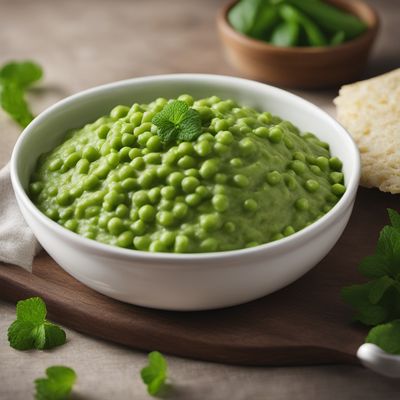
Ingredient
Marrowfat pea (dry seeds)
The Mighty Marrowfat: Exploring the Power of Dry Peas
Marrowfat peas are large, pale green peas that have been allowed to mature and dry on the vine. They have a starchy texture and a slightly nutty, earthy flavor. When cooked, they become soft and creamy, making them ideal for purees, soups, and casseroles. These peas are often used in traditional British dishes like mushy peas and pease pudding.
Origins and history
Marrowfat peas have a long history dating back to ancient times, with evidence of their cultivation in the Mediterranean region and Asia. They were introduced to Britain during the Roman Empire and became a staple food during the Middle Ages. Marrowfat peas gained popularity in the 19th century as a cheap and nutritious food source for the working class. Today, they are still widely cultivated in the United Kingdom and are enjoyed in various cuisines around the world.
Nutritional information
Marrowfat peas are a nutrient-dense ingredient, packed with plant-based protein, dietary fiber, and essential vitamins and minerals. They are low in fat and calories, making them a healthy addition to a balanced diet. A 1-cup serving of cooked marrowfat peas provides approximately 200 calories, 14 grams of protein, 10 grams of fiber, and significant amounts of iron, folate, and vitamin C.
Allergens
May contain traces of gluten.
How to select
When selecting marrowfat peas, look for dry seeds that are uniform in size and color. Avoid any peas that appear discolored, shriveled, or damaged. It's also a good idea to check the packaging date to ensure freshness. If purchasing from a bulk bin, make sure the peas are stored in a clean and well-sealed container.
Storage recommendations
To maintain the freshness and quality of marrowfat peas, store them in an airtight container in a cool, dry place, away from direct sunlight. Properly stored, they can last for up to a year. Cooked marrowfat peas should be stored in the refrigerator and consumed within 3-4 days.
How to produce
Marrowfat peas can be grown in a home garden by sowing the seeds directly into well-drained soil in early spring. They require full sun and regular watering. Harvest the peas when the pods have turned yellow and the seeds are dry and hard. Allow the peas to fully dry before shelling and storing.
Preparation tips
Before cooking marrowfat peas, it's recommended to soak them overnight to reduce cooking time and improve digestibility. To cook, rinse the soaked peas and place them in a pot with fresh water. Bring to a boil, then reduce the heat and simmer for 45-60 minutes, or until tender. Marrowfat peas can be used in a variety of dishes, including soups, stews, curries, and salads. They can also be mashed or pureed for a creamy side dish or spread.
Substitutions
Green split peas, yellow split peas
Culinary uses
Marrowfat peas are commonly used in traditional British dishes such as mushy peas, pease pudding, and pea soup. They are also a popular ingredient in Indian cuisine, where they are used in curries and dals. Additionally, marrowfat peas can be added to salads, grain bowls, and vegetarian patties for added texture and flavor.
Availability
United Kingdom, India, Mediterranean region, Asia

